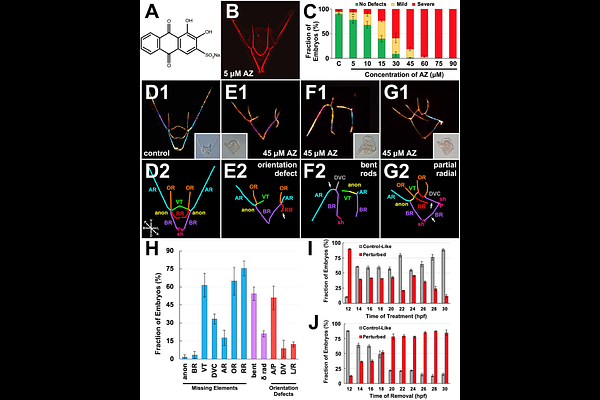Alizarin red perturbs skeletal patterning and biomineralization via Catalase inhibition

Alizarin red perturbs skeletal patterning and biomineralization via Catalase inhibition
Descoteaux, A. E.; Radulovic, M.; Ghogale, M.; Chandragiri, S.; Shrestha, B. D.; Abayawardena, D.; Wikramanayake, A.; Prakash, V. N.; Bradham, C. A.
AbstractAlizarin Red S (AZ) is an anthraquinone dye that is commonly used in histological studies and textiles. Exposure to AZ results in morphological perturbations in several species, including rats, frogs, and dogs; however, the mechanisms by which AZ has these effects is largely unexplored, and little is known about its effect on development. We have previously shown that AZ is teratogenic to sea urchin larvae, and that AZ was the only calcium-binding mineralization marker among five tested that perturbed skeletal patterning. Here, we further characterize these defects and demonstrate that embryos exposed to AZ have abnormal skeletal element rotation, branching, and bending. Immunostains and polychrome labeling reveal delayed migration of primary mesenchyme cells and initiation of biomineralization. Although gross ectodermal dorsal-ventral specification, ciliary band restriction, and neuronal specification occur normally in the majority of AZ-treated embryos, we find abnormal patterning and connectivity of the serotonergic neurons. Temporal transcriptomics comparisons confirm delayed development and implicate changes in neuron-related GO terms with AZ treatment. Particle imaging velocimetry experiments show that ciliary beating normally directs fluid flow into the larval mouth, while AZ treatment perturbs the normal pattern of vortices and redirects flow away from the mouth. These changes in fluid flow have functional consequences for larval feeding behaviors in AZ-treated embryos. Finally, we show that the effects of AZ on skeletal patterning are largely due to its inhibition of catalase and subsequent elevation of reactive oxygen species. Specifically, catalase knockdown and transient hydrogen peroxide treatment are each sufficient to phenocopy the hallmark AZ-mediated skeletal patterning defects. This study is the first to define the teratogenic consequences of AZ exposure and show how its effects on catalase activity impact development, skeletal patterning, and biomineralization.